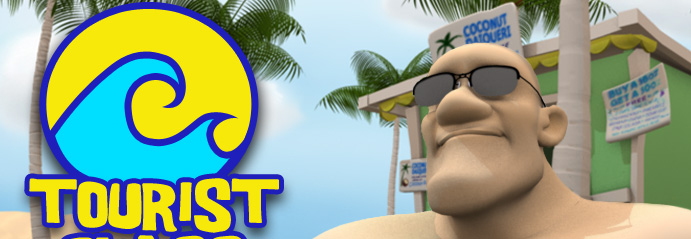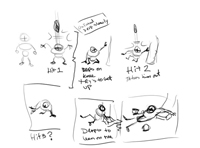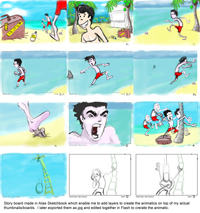
|
|
|
|
|
|
 |
|
|
|
 |
|
|
|
|
|
|
|
Animation Mentor: How did you come up with the concept for your short film?
Peer Lemmers:
At the end of class 4 I asked a mentor to look at my work, and he felt my body mechanics were not convincing. I decided then that I wanted a physical short so I could work on this, get out of my comfort zone and experience a stronger learning curve. Sound advice from mentors and students drove me to make something focused on what I could do within the three month timeframe we had. I looked for something that I could pull from my own experience. I was currently living in the Bahamas and wanted to show that even paradise has its down sides because all my friends thought I was just happily chilling under a tree. And yes I've actually been chased out of the water by a shark. Luckily for me, there were no coconuts involved as they kill more people statistically than sharks.
Animation Mentor: What important lessons did you learn from making your short film? Peer Lemmers: Animation Mentor: How long did it take to complete your film? Peer Lemmers: Animation Mentor: How much planning was put into your short film? Did planning help make the process easier? Peer Lemmers: Animation Mentor: Do you mind sharing some of the pre-production work with us with a little explanation of what we're looking at. Peer Lemmers: This is the beach I lived 10 minutes away from while in Freeport, Bahamas. I spent most of my time there when not behind my computer. I was trying to keep my sets as basic as this beach. I love the wide simple decor and tried to translate that to my film. I based the rum hut on this actual one in the downtown area of Freeport.
This is one of my very simple thumbnails of how he could get hit by the coconut; this is very minimal but tells me exactly what I’m looking for.
In class 5, I set out to board as much as I could and I really enjoyed doing it! At this point I had not made the decision to change Bishop to Ace (the big muscular character Animation Mentor provides). As I turned my boards into an animatic and started watching it over and over again, I thought I needed more contrast and that it would be funnier if he was a big macho character getting his butt kicked by the elements of a beach environment. Having a big guy scream like a girl is much more fun to me than a small wimpy one as you sort of expect that. Also, at this stage I had not thought of the dive into the ocean shot yet. He still walks in here, but as I got more and more into the animation part of things I thought to myself, “What do I always do when I see the ocean? What do most other people do when they reach that beautiful beach in the Tropics?” I wanted him to get in touch with his inner child here; this was far more entertaining and also not so expected after the previous shot where he is introduced to the viewer by taking off his shades and being a big presence. Getting inside the character’s head is incredibly important. Sometimes it comes easy, sometimes not, and that is why I had a little note pad on me as things would pop up into my mind in the most unlikely places. Making a simple note was enough for me to remember so when I would get back to my shot at night after work it was easier to get back into things.
So this was my final animatic at the end of class 5. By the time I went into class 6 I had made some fundamental changes to the sequences as I was looking for more entertainment in my animation and wanted to push the ideas a bit more. I was continuously open to new ideas from my mentor and fellow students and I kept looking for better ways to execute what I had. I am not saying this is the way to go, in an ideal world I would have thought of all of this in advance, but for me it really remained an organic process all the way to the point of switching to spline. After that I did not change much at all.
For such a physical short I felt I needed a lot of video reference, as one of my goals on this film was to get a really solid body mechanics demo. Video reference also allows for quick and easy experimenting. I tend to shoot a lot and then choose the one I feel suits the situation best or has something unexpected in it. I would then import the video into Flash and make notes on top of the video reference, to break down the movement and to understand what is happening in the body. This gave me something solid to start from but I only used it as that. I feel my imagination is stronger than any video reference I can act out. I feel if you stick to your video reference exactly as is your animation tends to fall flat and you might miss some great opportunities to push things more and get a more lively feel to your animation. This is just my opinion and workflow; every animator has their own process and I'm sure my way doesn't work for others like theirs might not work for me. This is a really important process to learn and while attending Animation Mentor my workflow changed with just about every assignment I did. Now, as I am more comfortable with the process it's more a matter of tweaking my workflow. Sometimes I simply couldn’t shoot video reference for a shot, like when my character dives into the water and floats around and reacts to the sharks. That's all me and the stuff inside my head. This is where little thumbnail sketches and a lot of trial and error come into place.
This is the layout based on my animatic. At this point I thought it would be funnier to show the full impact of the coconut hitting him and his reaction to it.
At this point the major changes would be the cameras for a more cinematic feel. The backgrounds have been more defined and the dive into the water has been introduced.
The end result, oh joy oh joy Ren! Actually finishing the short and seeing it all come together is one of the best feelings of achievement I’ve had. Now the time of a good night sleep is back upon us :-)
Animation Mentor: What obstacles, if any, did you experience during the creation of your short film? How did you work your way around them? Peer Lemmers: The main obstacle for me was myself. I was continuously tempted to add/change things to the story and had a hard time sticking to the idea that I initially had. Partially this was because I had so much time in between class 5 and class 6. The way I saw things had changed, and I wanted to implement my new ideas as much as possible. However, due to the production schedule of my short and also working full time it was really important that I didn't. In hindsight I'm glad I stuck to what I had since it allowed me to focus on the animation side of things, which is what class 6 is all about. Animation Mentor: Tell how your Animation Mentor experience helped you in creating your short film. Peer Lemmers: |
|


